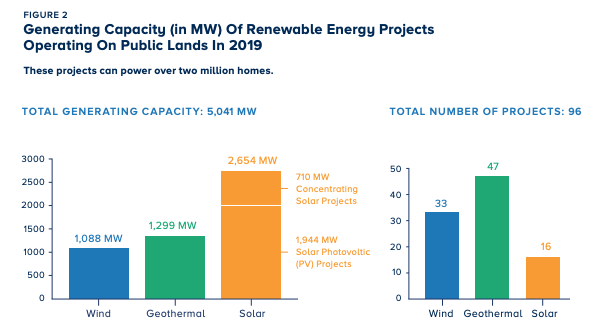Report highlights great benefits of geothermal on public lands in the U.S.
The recently published report on benefits of renewable energy development on public lands in the U.S. highlights not only revenues, but also the economic benefits of geothermal energy in the form of local job creation.
An interesting report published in May 2020 by the Yale Center for Business and the Environment and the Wilderness Society shares details on the “Key Economic Benefits of Renewable Energy on Public Lands” [in the United States]. The report is available here (pdf).
“America’s federal public lands have been an important source of energy for over a century, along with providing other important resources and amenities like clean air and water, recreation opportunities, and sustaining wildlands and wildlife habitat. Our nation’s energy needs continue to grow and evolve, and renewable energy generation on public lands has now also become a contributor to a diverse and sustainable national energy portfolio. Renewable energy generation on public lands makes important contributions to our economy.”, so the report.
The report highlights that “increased renewable energy development has many benefits, it is not without its impacts and challenges”, but pointing that continued investment in and commitment to the smart approach for renewable energy development can achieve the goals of more efficient project permitting and responsible use of public lands.
Solar, wind, and geothermal energy reduce the country’s dependence on fossil fuels, protecting clean air and water and addresses the threat of climate change.
The report shows that “there is immense value in continuing to support the responsible development of renewable energy on public lands.”
“In 2019, there were 96 utility-scale solar, wind, and geothermal projects operating on public lands with a total generation capacity of over 5,000 megawatts (MW), enough energy to power over two million homes.”
The report highlights the important role of geothermal power generation on public lands in the U.S.
Of the 5,041 MW of renewable energy power generation capacity, geothermal represents 1,299 MW with 47 of 96 projects in total.

Interesting is the evaluation of the federal revenue from renewable energy sources on public land. The federal government collects and deposits in the federal treasury several different fees pertaining to the use of federal lands for the production of renewable energy by private industry. These fees vary by energy type and location. The main types of fees are: 1. Per-acre land rental fees; 2. Royalties (for geothermal) or MW capacity fees (for solar and wind); and 3. Minimum and bonus bids as part of the competitive leasing process.
It seems to have been difficult to get the numbers together, but nevertheless it highlights the important funds generated from geothermal, both for the federal government, but likely more importantly on the state and county level.
Between 1982 and 2019, a total of revenue from geothermal energy of around $460 million (in 2019 dollars) was achieved. For the period of 2006 to 2019, the revenue collected included $79 million distributed to countries, $158 million to states and $79 million to the federal government (in 2019 dollars).
Capital invested in geothermal energy development on public lands since 1996 (in 2019 dollars) was estimated at around $1.1 billion.
Another aspect highlighted in the report is job creation from renewable energy development and operation on public lands. This highlights the great job creation capacity of geothermal, as its much more a local resource with implications for local communities than the other renewables.
Particularly interesting is the fact that geothermal energy provides not only temporary construction jobs, but long-term operations and maintenance jobs that local economies can profit from.
For number nerds, the jobs/ MW for geothermal project construction is estimated at 3.1 jobs/ MW installed capacity. Jobs/ MW for geothermal project operations and maintenance is 1.17 jobs/ MW installed capacity.
With the particular importance of renewable energy development and operation in the State of Nevada, specifics are provided for this state. “Geothermal energy revenue collected between 2006 and 2019 in Nevada included $32,405,623 distributed to counties, $64,811,245 distributed to states, and $32,405,623 retained by the federal government in 2019 dollars.”
The report closes with concrete proposed action items to support further renewable energy development on public lands with clear opportunities for growth.
Source: Yale Center for Business and the Environment & The Wilderness Society